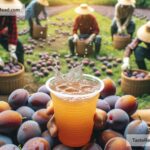The Role of Glucose in Fruit Sweetness
Fruit is nature’s candy. Whether biting into a juicy mango, savoring a ripe peach, or munching on a handful of sweet grapes, it’s hard not to appreciate the delightful taste of fruits. This sweetness, a key factor in why we love fruits so much, largely comes from sugars inside the fruit. But did you know that one of the main sugars responsible for that sweetness is glucose? Let’s dive into what glucose is, how it works, and its role in the flavor of fruits.
What is Glucose?
Simply put, glucose is a type of sugar. It’s classified as a “simple sugar” because it is made up of just one molecule. Glucose is one of the most important energy sources for living things, including both plants and animals. In humans, glucose fuels the cells in our bodies, keeping us alive and energetic. In plants, glucose plays a similar role, supplying energy and helping them grow and thrive.
Fruits naturally contain sugars, with glucose being one of the main types alongside fructose and sucrose. These sugars are what give fruits their sweet taste. The exact sweetness of a fruit depends on the type and amount of sugar inside it.
How Does Glucose Form in Fruits?
Glucose isn’t added to fruits—it’s created within them as part of a natural process. Remember, fruits grow on plants, which rely on sunlight and the process of photosynthesis to produce food and energy.
During photosynthesis, plants take in carbon dioxide from the air, water from the soil, and sunlight to produce glucose. This glucose is then used by the plant to power its growth, create new tissues like leaves and stems, and develop fruit. As the fruit grows and ripens, glucose gets stored inside, adding to the levels of sweetness.
Ripening is an important part of this process. As a fruit ripens, its natural sugar content increases, and its flavor becomes sweeter. That’s why a green, unripe banana tastes bland and starchy, while a yellow, ripe banana tastes sugary and satisfying.
Why Glucose Matters for Fruit Sweetness
Glucose is one of the simplest sugars that contribute to fruit sweetness. It has a mildly sweet taste compared to other sugars like fructose—the sweetest simple sugar—or sucrose, which is common table sugar. However, glucose still plays a vital role.
When fruits ripen, their sugar composition changes. There’s usually a balance of glucose, fructose, and sucrose in the fruit. The ratio of these sugars can affect how sweet a fruit tastes. For example:
- Fruits high in fructose tend to taste sweeter than those high in glucose because fructose has a more intense sweetness.
- Fruits that contain equal proportions of glucose, fructose, and sucrose may taste perfectly balanced with a mild sweetness.
Each fruit has a unique sugar profile—and that’s why they all taste different. A watermelon’s sweetness feels lighter than the thick, syrupy flavor of a fig because its sugar composition is different.
Examples of Fruits and Their Glucose Levels
Let’s look at some common fruits and their glucose contribution to sweetness:
-
Apples: Apples have a mixture of glucose, fructose, and sucrose. Their balance leans heavily on fructose, which is why they taste quite sweet even when fresh.
-
Bananas: Bananas are packed with glucose and sucrose, and their sugar levels increase as they ripen. That’s why a fully yellow banana tastes significantly sweeter than a green one.
-
Grapes: Grapes contain glucose and fructose, which make them naturally juicy and sweet. Their high sugar content makes them a favorite snack and ideal for turning into wine.
-
Citrus Fruits (e.g., oranges): Oranges have glucose, fructose, and sucrose, but the balance can be affected by the variety. Some oranges taste sweeter, while others are tangier, thanks to other components like citric acid.
Glucose and Fruit Ripeness: A Key Connection
Glucose levels are linked directly to fruit ripeness. When a fruit is still growing, it may have lower sugar levels, and its taste can be bland, sour, or slightly bitter. As the fruit ripens, more glucose is created and stored, alongside other sugars. This makes the fruit sweeter and more appealing.
Farmers and fruit growers often monitor the sugar levels in their fruits to determine whether they are ripe enough to harvest. Too early, and the fruit might lack enough sweetness. Too late, and the fruit might spoil or taste overly sweet for some people.
Why Fruit Sweetness Matters for Plants and Humans
Fruit sweetness is not just about our enjoyment—it also serves an important purpose for plants. Sweet fruits attract animals, birds, and humans to eat them. Once consumed, the seeds inside the fruit are carried away and spread to new locations, helping the plant reproduce. Sweetness is basically a plant’s way of persuading us to help them grow.
For humans, fruit sweetness provides a natural energy source. Glucose is rapidly absorbed into the bloodstream, giving us quick energy when we eat fruits. That’s why fruits are such a healthy snack—they taste good and help refuel our bodies.
Conclusion
Glucose plays a key role in fruit sweetness. As one of the main sugars found in fruits, it contributes to the flavor profile and gives fruits their delightful, natural sweetness. Whether it’s a ripe mango, a sweet grape, or a refreshing slice of watermelon, glucose helps make fruits appealing to both humans and animals. So the next time you bite into your favorite fruit, take a moment to appreciate the science behind its sweetness—it’s all thanks to glucose!


